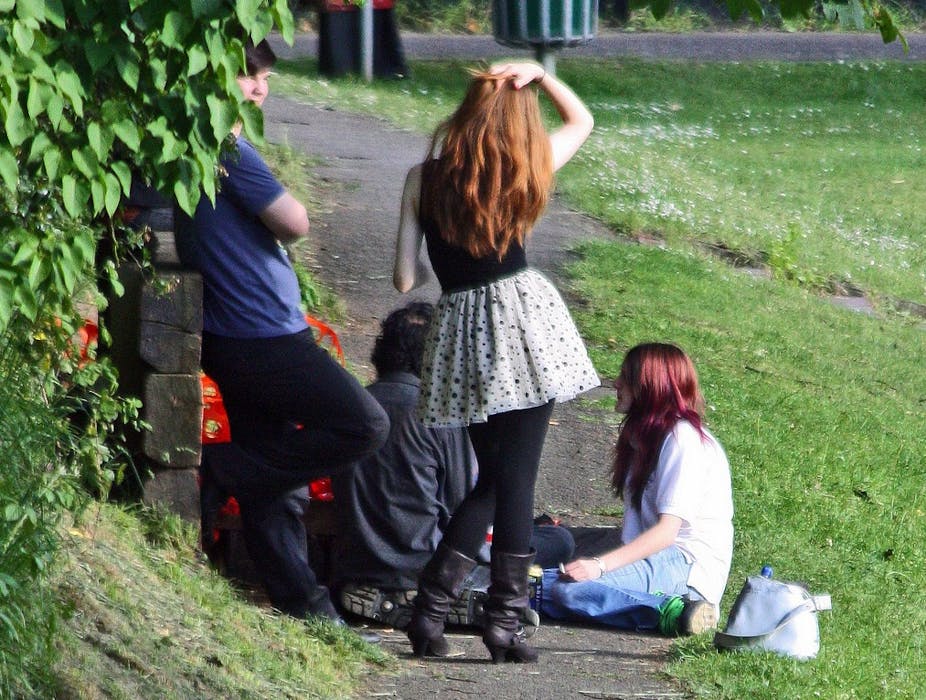A study published today in the Lancet shows that while self-harm is relatively common among teenagers, most young people will naturally stop hurting themselves as they develop biologically and emotionally. But persisting anxiety and depression are the red flag for parents and guardians to seek assistance.
The focus of the paper is deliberate self-harm and at each of the study points, we asked the study participants about recent self-harm: have you deliberately (on purpose) done something that you knew at the time could have seriously injured you or killed you? And we asked them to give a description of what they did.
That information was coded into categories according to whether it was:
-
self-laceration, the commonest form of self-harm;
self-poisoning, second most common;
deliberate risk-taking, activities such as train surfing, deliberating jumping into oncoming traffic or from a height in such as way that you could break a leg or kill yourself; and
self-battery, such as punching and wall and breaking a bone through doing so, or having significant bruising as a result of it.
Risk group
Self-harm is commonest in the younger teenagers – at the age of 15, 5% of teenagers we were studying were self-harming. That fell by the late teens to 1.5%, and to half a percent by the age of 29.

Girls do more self-harm than boys so at just under 16, 3.6% of boys self-harmed but for girls the rate was 6.5%. By the time we get to the mid-twenties, the gender ratios equalise and self-harm is much less common over all.
The clearest factor associated with self-harm and predictive of its onset are emotional problems characterised by depression and anxiety. We’ve looked at kids who reported high levels of depressive and anxiety symptoms and they had a fourfold increase in risk of reporting self-harm six months later.
But there are a range of other factors, such as alcohol and substance use – both tobacco and cannabis use – linked with the onset of self-harm. There are also other studies showing early sexual activity is predictive of self-harm.
And this is really a group one can characterise as the group that’s on a fast-track to adulthood. We know from other studies that they tend to be on the margins of family and at school.
The roots of self-harm
Self-harm is a response to emotions that feel intolerable and unbearable. Dealing with that emotional distress by cutting or taking overdose are what self-harmers often report as making them feel grounded again.
The underlying stress “disappears once I actually see blood appear” is a common kind of response self-harmers report.

Most develop other ways of dealing with difficult emotions with time. But for around one in five of those who self-harmed in their teens, it’s a more persistent pattern. For these people, it continues beyond a few months, to a year or more. And that’s the group that’s a little more stuck in using self-harm as a way of dealing with distressing emotions.
Biological basis
We think one of the reasons for self-harm peaking in the mid-teens and the decline in prevalence and incidence after that is its underlying biological basis. There’s a link between pubertal states at a given age – girls in late puberty are over four times more likely to self-harm than those at an early pubertal stage.
Puberty may be important for a couple of reasons – it may have something to do with the activating effects of changing hormones that in turn have a profound effect on emotions.
The other thing that changes around this time are the sub-cortical structures that are the site where emotions arise. At least in animal studies studies, we know that puberty is the time for the re-sculpting of these sub-cortical structures probably in preparation for mating and parenting.
Young women in particular report much greater difficulties in dealing with emotion such as anxiety, anger and unhappiness, and knowing how to relax when they’re tense as they pass through puberty. And that may be a reflection of some process of this kind.

In contrast, the part of the brain involved in the regulation of emotions, which are cortical structures (so-called pre-frontal cortex), is one of the last parts to really mature. That’s a process that continues right through into the late 20s.
So we have a window of vulnerability that reflects a developmental gap in the structures involved in the generation and regulation of emotions. And that may be one of the reasons why we see this high rate of self-harm during the mid-teens and a rapid fall away after that.
Intervention and guidance
The first implication of our findings is that this is a life phase with greater susceptibility to emotional hazards than others. That’s likely to do with the biology discussed above. Many of us feel this is an age group that needs a “social scaffolding” to be in place.
This social scaffolding is made of good relationships with parents and other adults in the life of young people and good non-conflictual relationships with peers. I think we’ve probably neglected or failed to understand its importance during this phase of life.
Experiences that may be manageable at other times of life, such as bullying and victimisation, are harder both because the individual has a reservoir of experience and also because brain development equips the older individual better.
But the most important factor connected with self-harm is underlying emotional problems with depression and anxiety. I think when these symptoms are either very prominent or persistent or you have self-harm that’s not resolving within a few months, then you’re at at the point where, as a parent, I would seek intervention.

